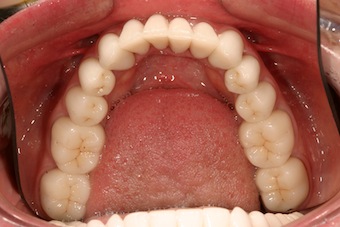Occlusion & Wear
Occlusal Reduction for Indirect Restorations: Is 1.5 mm Enough?
By Robert Winter on February 5, 2014 | Are the posterior indirect restorations you receive back from your laboratory, relatively flat compared to your expectations? Is it your laboratory's fault for not developing proper morphology in the occlusal surface, or is the lack of occlusal reduction in your preparation resulting in inadequate space to develop the anatomy?
Are the posterior indirect restorations you receive back from your laboratory, relatively flat compared to your expectations? Is it your laboratory's fault for not developing proper morphology in the occlusal surface, or is the lack of occlusal reduction in your preparation resulting in inadequate space to develop the anatomy?Possible reasons for 'flat' occlusal anatomy include:
- The skill of the technician is inadequate to develop proper anatomy.
- There is not adequate space for the technician to maintain the minimum thickness of restorative material recommended by the manufacturer to retain adequate strength (e.g., IPS e.max requires a minimum of 1.5 mm of material on the occlusal surface).
- Over-milling may occur if the internal aspect of the restoration has sharp edges or corners on the preparation. This creates space between the tooth preparation and the ceramic resulting in reduced material thickness, and does not leave enough room to develop the anatomy.
- Inadequate occlusal tooth reduction in the central groove by the clinician.
When preparing posterior teeth for occlusal coverage (onlays or crowns), old restorative material that has a flat occlusal anatomy typically exists in the tooth. This occurred because the tooth was overfilled and flattened to achieve occlusal contact in its center. If the old restoration was flat and you now reduce the tooth 1.5 mm uniformly, the new restoration will have anatomy similar to the previous one.
There will not be enough room for the technician to create the desired natural anatomy and still maintain adequate material strength. You must reduce the tooth 2.0 mm in the area where you want a central groove so the technician has 0.5 mm of space to create anatomy that is more natural appearing.
How do you check to make sure there is adequate space for the restorative material and desired anatomy?
Some clinicians measure the thickness of the bite registration at the approximate location of the central groove. If it measures 1.5 mm, they think there is enough space for material and anatomy, when in reality it is the distance between the preparation and the opposing cusp.
It should measure 2.0 mm. for there to be room for the required material thickness and the desired anatomy. It is also possible to measure the thickness of the provisional restoration. If it is at least 1.5 mm thick and has the anatomy you want in the final restoration, the tooth is adequately reduced. If not, additional reduction is necessary. Remember, when preparing the tooth, there is no need to over prepare the cusps, you only need to deepen the central groove.